Text
In case you missed it, here’s my newest review. I reviewed Kirby Air Ride back in 2015 but I think this 2019 version is much better one. There’s also a video version of this review (which I think helped a lot, since 3MB GIFs can only do so much to get the point across) so... yeah.
Kirby Air Ride Re-Review
View the video version here. View the older version here.
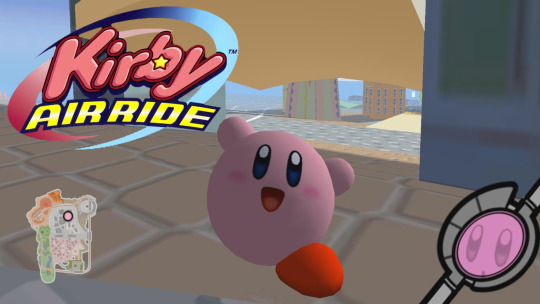
Weiterlesen
14 notes
·
View notes
Text
Kirby Air Ride Re-Review
View the video version here. View the older version here.

The Kirby series was made with simplicity in mind. You couldn’t even run in the first game and even in the newest games, the gameplay is quite simple and plays well because of it. Spin-Off games for the pink puff ball however never quite followed this rule. Sometimes the controls get complicated, sometimes the gameplay wasn’t as straight forward as the main entries.
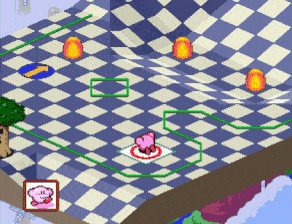
But for the last game directed by its creator, this spin-off game did follow the “simple to play easy to master” principle and delivers it amazingly well. It took 8 years to make but they’ve delivered it nonetheless.
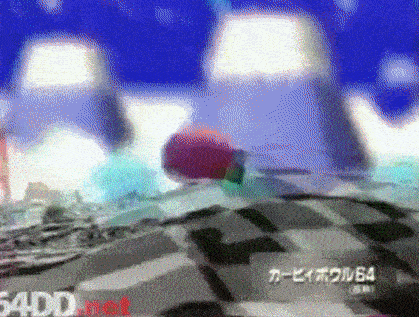
Kirby Air Ride is a mix of party and racing game and was developed by HAL Laboratory.
The controls are extremely simple: Almost every vehicle, or “star” as the game calls it, accelerates on its own. If you fly off a ramp, you can tilt your star up into the air to gain height, then fly forwards and land correctly to earn a boost.
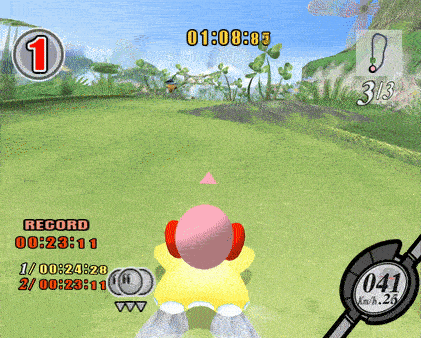
Besides that, the analog stick is only used for steering. And every button on the controller does the exact same thing. Drifting, braking, absorbing enemies and using your copy abilities, activating switches and boost pads… Everything with just one button.
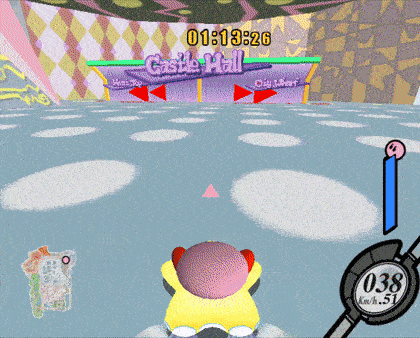
You could even play the game in one hand and eat pizza in the other! ...Get it?
“Air Ride” is the racing mode. 9 courses with a ton of options. You can decide how many laps you’ll race, whether or not enemies should appear, heck, maybe you want a time limit instead. The courses themselves make use of a lot of corner drifting but are also populated with tons of enemies. Defeating enemies gives you a little extra speed for a while too so it becomes a balance act of messing with your opponents and enemies but also trying to get boosts in various ways.
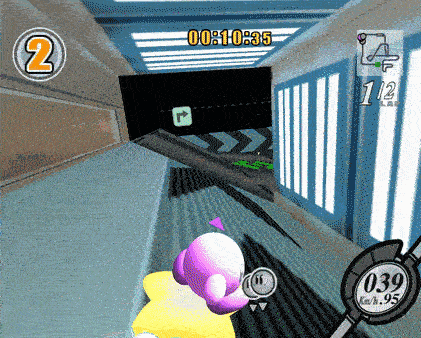
There are also 2 separate time trial modes (one with enemies and a specific number of laps and the other without enemies and infinite laps; saving the best lap time instead) and if you want to get extra competitive, you can enable a lifebar. Having a lifebar makes a huge difference on the balancing act. Now you want to defeat your opponents more so than getting boosts but focusing on that too much could also make you lose 1st place. See how “simple to play easy to master” just works amazingly well with this? There’s just one flaw with this: There aren’t enough courses, at least in my opinion. What we have is great though. And if you want to get extra unnecessary, you can use a broadband adapter to play it with up to 4 GameCube systems via LAN… but why would you do that? It will still only support 4 players, so just play 4 player splitscreen with one console.
“Top Ride”’s mode is about races from the top-down perspective. You can choose to turn your star left or right or hold the analog stick in the direction it should go. Each of the 7 courses has a different theme with an obstacle or a gimmick. Players can pick up various items and abilities.
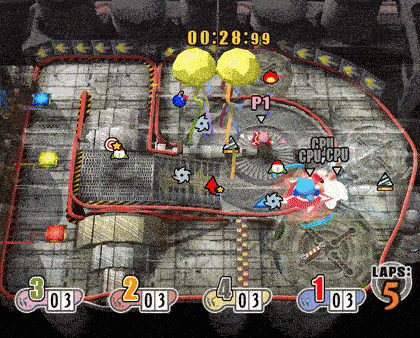
This mode is definitely more party orientated. With Top Ride, you can easily conquer 1st place with items, while Air Ride rewards good driving skills more.
And there are two separate time trials again. There’s not much else to say besides mentioning that you can unlock songs from older Kirby games for this mode. And that Kirby looks kinda squished. And there’s not much else to say besides that…
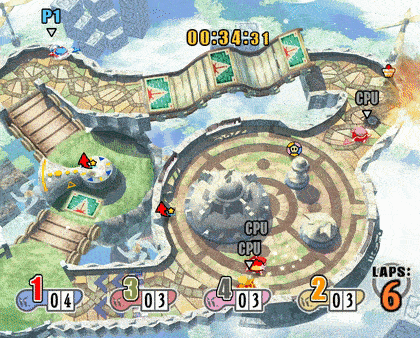
Wait, that’s the issue! There aren’t enough courses, all of the stars from Air Ride are gone (which do return in the next mode)… Maybe if the courses would be bigger, I wouldn’t think it’s that bad? And why are the control styles separate stars, when nearly all of them before controlled the same way? It’s the worst mode in this game but it’s not a bad mode. Just painfully average.
In City Trial, you powerup your star by collecting items. Collecting a lot of weight makes your star less slippery, glide lets you fly higher and glide faster, top speed increases your top speed and so on. You start off with a standard star, the Compact Star. It’s quite weak but you’ll also find different stars that you can hop onto instead and find the star that you’d prefer. Make sure that you’re not losing your items or your star by defending yourself against the other players. Or you could mess up their day, either or.
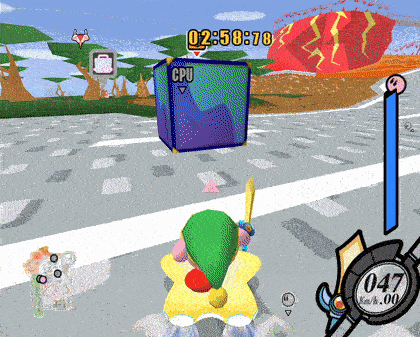
There are also random events that can make your life harder or easier. For example, Dyna Blade can appear and you need to hit her head to defeat her. It’s a little hard to hit here but you’ll get the hang of it. Other events are kinda nice and surprising too, but I need to mention 2 bad ones. One is where the items get bouncy. They’ll bounce really high and it’s kinda just frustrating when you see an item and you have to make sure the item lands where you’d predict it to fall.
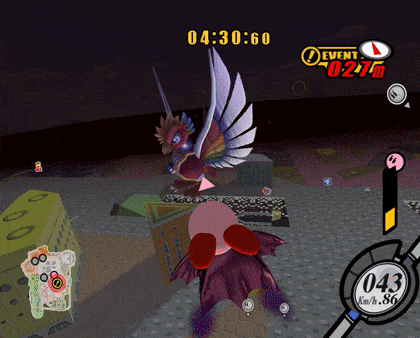
But the worst one is “Air Ride machine transformation approaching!”. See, what they’ve intended you to do is fly up to the flying machines, hop off your current machine and jump onto one of the flying ones to take it. But if you take more than one or try to bump into them to bring them from the sky, the game crashes. Maybe the developers had to get that event out of the door and didn’t have time to debug it but it’d have been better to not include at all. But again, the other events are fun.
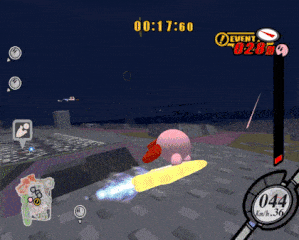
The mode ultimately ends in a minigame to determine the winner. It could be about who can fly the highest, who can defeat the most enemies under a time limit, and so on. But you might be able to predict it with a hint that can sometimes pop up. If that sounds familiar, you might be thinking of Super Smash Bros. 3DS’ Smash Run mode. Same basic principle but Kirby Air Ride does it a lot better by having a number of settings that aren’t present in Smash. Like setting the minigame, the time limit, how many items can appear, letting all players compete in the same arena, basically it’s just way better.

I also think that Kirby Air Ride has way better minigames. I mean, yeah, sure, beating up as many enemies as you can in Smash 3DS is fun and all but you’re not a living dart flying into a target or... defeating enemies in 3D with a vehicle and stuff. So, yeah, City Trial is fun, chaotic and the best mode in this game. If someone brings up Kirby Air Ride, they’ll bring up this mode.
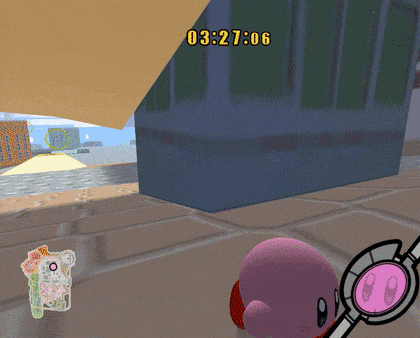
Also, HOLY MOLY YOU CAN CONTROL KIRBY IN A 3D ENVIRONMENT?!?! JUMPING AND PUFFING UP TOO?!?!?! THAT’S AMAZING!!
Finally, if this all doesn’t seem enough for you, there’s tons of replay value with achievements with a ton of unlockable content. And there’s not just 120 achievements. Not 240. But 360 of them. But just like what eventually Super Smash Bros. Brawl will do, you can skip some of them by using purple boxes. How do you get those? By doing other achievements, of course. And some will unlock songs, some will unlock skins, some won’t do anything at all. You’ll never know until you do them. Whether on purpose or on accident.

Maybe you’re asking “why would I want Kirby Air Ride when I could get Mario Kart: Double Dash!! or F-Zero GX”? That’s because the game doesn’t want to be a chaotic fun-racer, nor a more realistic high speed racer. It kinda is parts of both? You could play it competitively but also have fun by messing with the other players. Kinda like the Smash Bros. games, you’ll have fun either way. And that’s why I recommend playing it.

14 notes
·
View notes
Text
Reblog, just in case people didn’t see it 17 hours ago. Have a happy new year, btw.
Money Puzzle Exchanger
A little NEOGEO game from ‘97 called Money Puzzle Exchanger by FACE got re-released this year on Switch, PS4, Xbox One and the Windows Store. I’ll be playing the Switch version for this review.

You can also see the video review version here.
Weiterlesen
6 notes
·
View notes
Text
Money Puzzle Exchanger
A little NEOGEO game from ‘97 called Money Puzzle Exchanger by FACE got re-released this year on Switch, PS4, Xbox One and the Windows Store. I’ll be playing the Switch version for this review.

You can also see the video review version here.
So, what is Money Puzzle Exchanger? There are three game modes here but all of them basically play the same.

Okay, so have you played Magical Drop? Well, this is that game… with math. It’s not as bad as it sounds, I promise! You have to drop and add coins to a pile and depending on the coins, you need to either have at least 2 or 5 of the same coins to make 1 new coin with a higher value. There’s 1, 5, 10, 50, 100 and lastly 500. There are also two items. Both can be activated by connecting a pair.

The green one upgrades the coins below the pair, so, for example, coins with a value of 1 get upgraded to a value of 5 and those generally will then create a combo or make it easier to clear a lot of coins in a quicker amount of time... and sometimes the coins just don’t disappear even though they technically should. Uhm… not sure why. The more useful blue item makes the coins below the pair disappear. And so by making a pile disappear, your goal is to get a big combo to make coins disappear in a row; you can even try to drop coins into a combo to let it last a little longer. Don’t let the coins reach all the way down and… that’s all you really need to know. If you’re still lost, I guess you can let the official in-game tutorial explain it. ...it’s not the best translation. Well… they tried their best.

So those rules might be a lot to take in but I can assure you that you’ll figure it out in about 4 to 5 minutes or so.
So, as I’ve said, we have three in-game modes in Money Puzzle Exchanger, the first one being a VS COM mode, which makes you fight against CPUs so that you’ll cut your teeth to get good at the game. Rank up combos to make coins fall fast for the opponent and that’s it. Simple but it works alright. But please, I encourage you to put the difficulty setting from Level 4 all the way down to Level 1. Even nowadays, I can’t beat the game with the standard difficulty. And even with Level 1, please have a lot of patience because it’ll drain a lot of your bottomless virtual wallet.

That’s why I advise you to select Solo Mode first where, unlike the CPU mode you can play as not just 2 but all of the characters in the game, which is pretty nice. They all don’t seem to have any differences gameplay-wise but a visual and song change is sometimes all you need to make a game not feel like you’re doing the exact same thing over and over again. Here, the coins fall quicker and quicker the more you level up. And so, after 3 to 5 minutes, the game is over and it’ll rate your performance on many factors to give you your final score.

It’s pretty addicting in a way and it doesn’t feel that frustrating once you lose. Well, in the English version anyway. In the Japanese version, that Game Over sequence can take quite a while… but thankfully, both versions are available on Arcade Archives.
2-player: It’s the CPU mode except both players can select whoever they like. Whoever wins twice is the winner. A second player can also interrupt the CPU mode to challenge player 1 and potentially take over. Also, I have to mention that these Arcade Archive releases don’t allow for online multiplayer, it’s couch multiplayer only which is a bit of a shame…

There are technically two more modes but outside of the game. Hi Score and Caravan.
Hi Score will record your score in CPU mode until you either get a Game Over or, I assume, play through the entire mode. Maybe it’ll just loop until you Game Over in the mode, I wouldn’t know because I’m not that good.

Caravan is basically the same thing but with a 5 minute time limit. Your score then can get uploaded to the internet. But I prefer the in-game Solo mode and the in-game version thankfully has its own leaderboard too. And by the way, the leaderboards don’t use Nintendo Switch Online so… that’s even better. But anyways, I don’t like these two extra modes all that much because I’m not a fan of the CPU mode. They also disable the turbo buttons and put it on the standard difficulty so everything’s just slower and too hard (for me) and because of *that*, I play worse than playing the normal game with those turbo buttons and a comfortable difficulty level. Maybe I could beat CPUs fast enough with an arcade controller with huge buttons… but with joycons? Nuh-uh, my thumbs just aren’t fast enough for these two modes.
As I’ve mentioned before, the Arcade Archive re-release also has the Japanese version.

Some graphics are different, some are exclusive to the Japanese version and there are extra voice clips. I also notice a bit of slowdown. But I suppose you won’t play the Japanese version that much anyways. It does make me screw up some moves here and there though and that’s not something you’d want in a fast-paced game where every input counts. Thankfully, I didn’t notice it in the English version.

Speaking of technical issues, I think there’s some amount of audio crackling. But that could also be just something that an average player wouldn’t notice without headphones. I sure didn’t until recording footage. It’s certainly not as bad as some audio emulations out there. At least the audio happens naturally without a noticeable delay, unlike NES Classic, NES Online or Mega Drive Classics on Steam or just plain freezes for half a second, unlike... Mega Drive Classics on PS4. I suppose these two exclusive bonus modes with the leaderboards can make up for these small issues.

Oh, and I like that you can remap buttons and use turbo functions for your button layout in the first place. That’s good. Other re-releases should have that too, hint hint. The turbo function seems to have a bit of lag to it though, it stops slightly later than when you let go of the button, that leads to some unwanted coins being dropped down. And that wastes time. Also, something I wish a sequel would do is a fast scroll option for the analog stick because in this release, you have to tap the direction for every step and that gets tiring after a while. Other puzzle games don’t have this problem because they let you automatically scroll left and right by simply holding down the direction. It’s not terrible that it isn’t here but, you know, it’d be nice to have.

I’ve mentioned that one mode is pretty addicting and that’s probably because it was originally an arcade release. Those were designed to get as much money as possible. Arcade Archives of course doesn’t make this financially dangerous but if you can’t tell yourself to take a break or to stop, the game really won’t stop that “one more try” mentality for you. If there’s ever gonna be a sequel to this (in a timeline where Bubsy gets sequels nowadays, anything can get sequels) I hope they’ll find a way to stop it somehow without being annoying like, e.g. a lot of 3DS games that tell you to “take a break”.
ANYWAYS, would I recommend Money Puzzle Exchanger? If this seems interesting to you… yeah, sure. You can get a lot of value for that price point and it aged pretty nicely. Now, I can’t tell you how well it holds up to Magical Drop though. since I’ve never played any titles from that series but… I’d rather stick to hectic math solutions than colors.

Money Puzzle Exchanger is available on Nintendo Switch, PS4, Xbox One and the Windows Store... and I suppose the Neo-Geo MVS, Game Boy and PS1. But this Arcade Archives version with the leaderboards, Hi Score and Caravan is on Nintendo Switch, PS4, Xbox One and the Windows Store.
#2018#Money Puzzle Exchanger#Money Idol Exchanger#Nintendo Switch#PlayStation 4#PS4#Xbox One#Windows Store#NEOGEO#Arcade Archives#Puzzle#Review
6 notes
·
View notes
Text
And here’s the reblog the second time.
By the way, the video review *should* be posted before 2019.
Oh, right, tumblr is dying...
Uhm… I’m gonna try to move onto making video reviews/essays(?) on my YouTube channel. I’ll try to make text versions of future reviews here too and slowly move fully onto YouTube with that but I know that a lot of accounts on tumblr that might follow me could get banned so…
https://www.youtube.com/c/ABlob
Go here and wait a little while for the first video review. Please have patience though; I hate my voice.

7 notes
·
View notes
Text
I guess I’ll reblog this twice more. Here’s the reblog a first time.
Oh, right, tumblr is dying...
Uhm… I’m gonna try to move onto making video reviews/essays(?) on my YouTube channel. I’ll try to make text versions of future reviews here too and slowly move fully onto YouTube with that but I know that a lot of accounts on tumblr that might follow me could get banned so…
https://www.youtube.com/c/ABlob
Go here and wait a little while for the first video review. Please have patience though; I hate my voice.

7 notes
·
View notes
Text
Oh, right, tumblr is dying...
Uhm... I’m gonna try to move onto making video reviews/essays(?) on my YouTube channel. I’ll try to make text versions of future reviews here too and slowly move fully onto YouTube with that but I know that a lot of accounts on tumblr that might follow me could get banned so...
https://www.youtube.com/c/ABlob
Go here and wait a little while for the first video review. Please have patience though; I hate my voice.

7 notes
·
View notes
Note
You should pray to god if they make a Mario Golf game for the Switch that wont suck, like Mario Tennis Aces did for the now much improved Mario Tennis fanbase...
I’ve heard that Aces was a disappointment and did the bare minimum for everything. That doesn’t sound that much improved (besides being an improvement over Ultra Smash’s nothing)...And I’ve never played a Mario Golf game besides a little of Toadstool Tour on a demo disk and I just couldn’t figure the controls out. And I’m pretty sure Mario Golf: World Tour was alright compared to Ultra Smash so I’d expect they’d do more of the same thing that already worked.
9 notes
·
View notes
Text
Maybe you've missed it but here's the new review.
Everybody’s Golf (Vita)

Everybody’s Golf (also known as “Everybody’s Golf 6” or “Hot Shots Golf: World Invitational”) is a golf game by Clap Hanz on the PlayStation Vita. I’m reviewing this game because I made a poll on Twitter where I’ve asked what I should take a look at. And because I never played a modern golf game before (besides We Love Golf on Wii, I suppose? I don’t remember much about it), it took quite a while to play/collect my thoughts/to write this. So anyways, let’s get into it.
Keep reading
7 notes
·
View notes
Text
Everybody’s Golf (Vita)

Everybody’s Golf (also known as “Everybody’s Golf 6” or “Hot Shots Golf: World Invitational”) is a golf game by Clap Hanz on the PlayStation Vita. I’m reviewing this game because I made a poll on Twitter where I’ve asked what I should take a look at. And because I never played a modern golf game before (besides We Love Golf on Wii, I suppose? I don’t remember much about it), it took quite a while to play/collect my thoughts/to write this. So anyways, let’s get into it.

The singleplayer has 3 modes: Challenge mode, Stroke mode and Training mode.

In challenge mode, you play 9 or 18 holes of golf against 19 CPU players with various objectives. Locations depend on the difficulty, the courses can be in mirror mode and sometimes there can be rain or a time limit for each stroke.

If you do well, you’ll earn points that you can spend in the shop for new characters, balls, golf sets, game artwork and so on. And if you get at least 3rd place in a challenge, you’ll earn a star which you need to face against a challenger that you can unlock in the shop once you beat him/her.

The courses all have a lot of detail, often have things being in the background (like a train or wildlife) and overall look great for a handheld game from 2011.

And is it just me or are the golf courses designed in such a way that you get punished for trying to be clever and making shortcuts with sandpit?

For a newcomer like me, I suck at golf and can’t imagine getting a hole-in-one ever. Sometimes, I think it’s impossible to hit the ball in a straight line but that seems to just be my imagination. Luckily, there’s an easy mode but unlocking it was a bit odd. It seems that you can only unlock it after losing a lot of times. I don’t understand why they’d do that? Newcomers would need to struggle (and potentially get frustrated) with the game and only then, they’ll get the easy mode. But what does easy mode do? From what I noticed, nothing besides making the score for the CPUs higher so you’ll get 1st place easier and adding a clover leaf to the menu if you used easy mode for the challenge.

Stroke mode lets you start whatever you want to play on and then you just play.

Training mode lets you skip courses, change the wind or redo shots which you’d think helps at learning how to play the game but when I redid the same shot over and over, I noticed that it often changes slightly. I’m not sure if luck is usually involved in golf games but that’s what it looked like to me.

Anyways, the music has this kind of relaxing Wii Sports-feeling to it and the graphics are often really good for running on a handheld. Manga-like graphical effects, like words that pop up for various soundeffects fit the semi-cartoony characters that you can also slightly customize. There’s even some added detail. You can use the rear camera to change the skybox to whatever the camera sees. Sadly, that makes the game nearly unplayable if you’re outside (to make the skybox actually fit the game’s environment) and you can’t make the screen of the Vita bright enough to see anything clearly. If you ever played a Nintendo DS (or 3DS) system outside in sunlight, you’d know what I’m talking about.

You can also touch trees and they actually shake. Using the rear touchpad to play around with the celebratory confetti on the ground is also unnecessary but neat.

Speaking of unnecessary: Your caddy. I don’t like their annoying and useless voice clips, but you can luckily turn that off. I don’t think it’s a big issue because of that, but just wanted to point that out.
There’s also something I’ve only noticed after playing the game for quite a while. If you use the rear touchpad while preparing a stroke, you can scroll with a glove through the golf course in front of you and it’ll tell you the length away from the player and the difference in height compared to the player. Maybe that’s helpful for experts but I couldn’t use it to my advantage. It’s strange the game’s manual never mentioned this feature...

Now let’s move on from singleplayer and look at multiplayer -- oh wait. I don’t know anyone close to me who uses a Vita and/or this game.

Uhm… then what about online mode--

Oh. The servers are dead. Well, that’s not nice.

But would I recommend Everybody’s Golf on Vita? If you want a difficult, great looking and portable singleplayer golf game… then the Switch probably will have one soon, maybe. But if it won’t get one, I suppose this is probably for you. It also came out on PS3 in 2012 apparently so… yeah. If you want an easy golf game, this isn’t for you, I have to say.
#2018#Review#PlayStation Vita#Everybody's Golf#PlayStation#Hot Shots Golf#Clap Hanz#Sony Computer Entertainment
7 notes
·
View notes
Text
Gurumin 3D: A Monstrous Adventure
This took some time because I had no idea what to write about all that time (and it was actually pretty hard to write about)… If you want me to write about something, check my backloggery page (https://backloggery.com/games.php?user=ABlob&status=2) and suggest me something. Thanks!
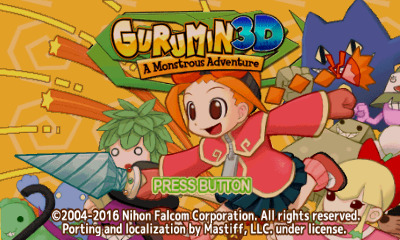
Gurumin 3D is an action-RPG game on the Nintendo 3DS eShop. It’s a port of the 2004 PC-game Gurumin which was later also ported to the PSP in 2006. Surprisingly not a Dreamcast title, even if it might resemble games for that console.

A little girl called Parin moves to a mining town full of adults. There, she discovers cute monsters and befriends most of them. Those monsters invite her to their monster world.

Suddenly, some evil phantoms attack, cloud the whole monster world into dark mist and kidnap her new friends. It’s up to Parin to save them with the help of a drill weapon from Monster Village that once sealed away an ancient evil. The voice acting is a bit corny but charming.

The world of Gurumin is split into a level map like Rayman 2’s. It’s a big worldmap that isn’t split into separate worlds that have nothing to do with each other (like Mario games), but rather points in that world where levels exist.

Often levels have a balance of puzzles, platforming and combat. You can push blocks, activate a switch here and there, jump awkwardly and tilt your model when jumping next to a wall and combat enemies.
Combat is kinda the focus of Gurumin: You’ll also find some elemental powers for the weapon, which means if you want to get an attack that is stronger (or weaker) against enemies, you can put on fire, ice or electric elements on the drill. Some puzzles also require these abilities to proceed. There are also outfits that give you certain effects, like more money per reward and letting you swim without taking water damage (as in, it hurts to swim in water unless you put on some goggles).
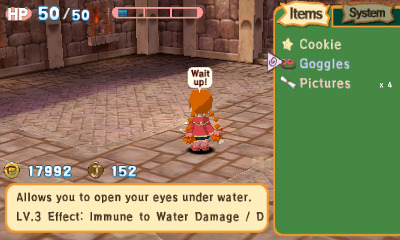
And finally, there’s also the level up mechanic where, if you find things to dig, you can level up the drill which deals more damage against enemies.
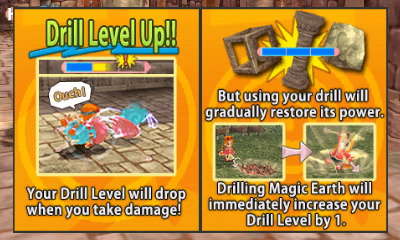
While that may sound complex, attacking the enemies is rather easy. At the start, you have a simple attack combo and a homing attack that works just like the 3D Sonic games (while in the air, press the attack button and then you zoom to the enemy and attack it) but you need to jump again to continue homing attack chains.
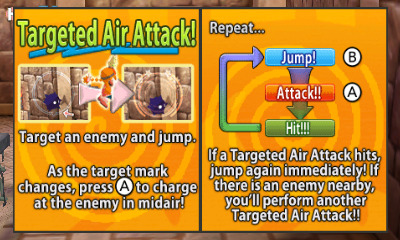
You can also get half a second of invincibility by dashing with X. That’s often used for avoiding enemy attacks or going through electricity barriers.

Later in the game, you unlock moves that you can do with button combinations. For example, dashing, turning around and then pressing the attack button will create a wave attack in front of Parin which is about 4 times stronger. And finally, there are upgrades for your drill and items that replenish your health.
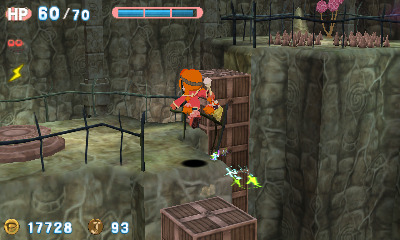
The original version of Gurumin had a rhythm bar for each background song because whenever you attack an enemy in the rhythm of the song, it counts as a critical hit but the 3DS port removes the bar. Not the feature, just the bar. I don’t understand that decision, was it too hard to put that bar on the bottom screen?
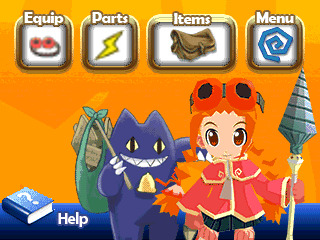
Because all it displays is a picture of Parin and one of her friends with some buttons that quickly switch your elementary powers and hats. There’s also a button for the menu, instruction booklet and inventory, but that’s already mapped to the Start button and is easier to access that way. The render of Parin fills up a lot of that screen. That space could’ve easily worked for the rhythm bar. Maybe they wanted to hide the rhythm bar because it’d go off-beat when the game has slowdown issues? I dunno.

Anyways, the levels look great for being on the 3DS and there are two kinds of them. There are levels that are open areas and hide something in them but don’t technically have an end of the level and then, there are levels that have an end of the stage but aren’t as open. But with that, I don’t mean they’re as restrictive as 3D Land’s linear levels or something. They’re kinda like Zelda dungeons without the backtracking.
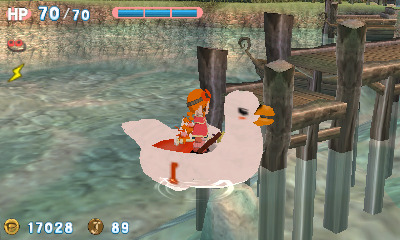
However, there are some issues I have with this port (besides the lack of the rhythm bar).
First off, something I cannot ignore. The framerate, it’s all over the place. Parin and the camera control pretty smooth but enemies, NPCs and objects look like they move around at 10 or 5 frames per second which makes them really hard to hit. It’s not unplayable but I had to rely on the homing attack for a soccer minigame because I couldn’t imagine beating the opposite team by predicting their and the ball’s stuttering movements. And don’t be surprised when the game suddenly slows down tremendously. The PC version (which is also on Steam) however seems to be at a stable… 30 frames per second.
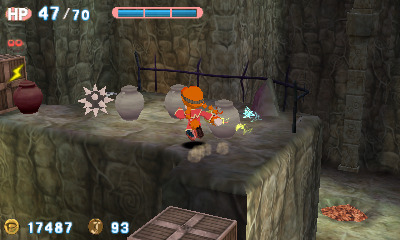
Next, pop-in issues. I noticed that the most with the coins. I think they’re supposed to disappear when they’re off-screen but they seem to disappear at the side of the screen. It’s a bit confusing when you go to pick up a coin, it disappears but when you get closer to it, it reappears.
This is just a little nitpick but Parin’s voice clips sometimes get deeper for no apparent reason. Maybe the game just can’t handle that? Who knows.
Something I don’t like about the game that’s not just this port’s fault is Parin often having to go all over the world map to do something that doesn’t take long to do, going to another spot on the map and then going to another one. Doesn’t happen too often but I don’t think that’s really funny or whatever they wanted to make those moments.
The soundtrack of Gurumin is okay but I can’t say much really stands out besides “Guruguru Tonight”. But none of the tracks are bad so that’s a plus.
But besides that, if you saw the trailers, thought it looked cool and these issues don’t matter to you, go pick it up. If you were scared of these issues of that rather unoptimized port, I’d recommend getting the PC version instead. I can’t say anything about the PSP version since I haven’t seen much of it and never played it so I’d recommend looking up gameplay footage and judge it for yourself.
I kinda actually wish they’d make a sequel to this so this kind of gameplay could improve but it doesn’t seem likely. But whatever, it’s still a fun, charming and inexpensive 10-hour distraction.
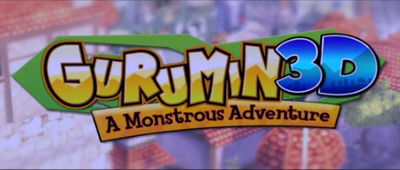
5 notes
·
View notes
Text
Paper Mario: Sticker Star
Paper Mario: Sticker Star is a fantastic action-adventure game for 3DS by Intelligent Systems who are very intelligent.

Speaking of intelligent, let’s jump straight into the deep story. Peach holds a festival that isn’t like the ones from past games, no-no. Because THIS time, Bowser kidnaps her! But before he does that, he shatters a star that gives a person a wish and pffff, who cares? Anyways, you then get a very helpful partner named Kersti. She’s beloved by fans and never annoys you. I mean, she appears as the very first picture when you look up “Paper Mario fanart”. Clearly that’s why the sequel of this game has a similar character, they listen to the fans. Her bickering and accusing Mario for things he/the player didn’t do is oh so funny and charming.

The gameplay is also a big improvement compared to The Thousand Year Bore, I can tell you that. Jumping and using your hammer? Who needs consistency with the out-of-battle gameplay?! Scrap it. EXP? More like… eeeeep, ex it. As in, X. As in, it’s bad and it’s gone in Sticker Star. Hooray! Partners? Hahahahahaha, who needs it? The attention needs to be on Mario, I mean, he’s in the title. It’s not “Mario and there’s also some other people here”. It’s “Paper Mario”! Finally, Intelligent Systems figured out how to improve Paper Mario by making the smartest decisions. We only need items and that’s all. It’s a good thing they threw everything, including the original staff that worked on the past games out. Because the past games are trash! This includes the world design too, who needs that actually. I think making every world just a simple New Super Mario Bros. world is very nostalgic to all the 2012 children who played Super Mario Bros. 3 in 1988. That’s exactly what they did, it’s simply good game design.

And levels now go on for hours which was really refreshing. Having to ponder what the simple solution is makes the player think they wasted their time a lot which is exactly what a video game should be. Like hitting invisible blocks to solve a level. It’s like someone who played Mario Maker made the level design. It has deep meaning because the world itself looks like a children’s pop-up book. As in, a child designed it. And having the player use the 3D functions without being reminded to use them ever is also a very smart decision. Walking behind a wall? Jumping into what looks like poison? Genius. And don’t tell me to use a guide, they designed the game in such a smart way that players never need to look up the solutions somewhere else. Never.
The music is absolutely amazing too. For example, just listen to this for hours, like I had to when originally playing this game. It’s a good thing they replaced the original Paper Mario-ish like instruments with loud jazz in the middle of development. Hmmm-mmm.
With all of that being said, I have small nitpicks I had to mention. 1) being that bosses are no longer challenging because you just have to use a specific sticker and that’s often all you need. They should’ve done a quicktime event during every boss where if you fail, you have to rewatch an unskippable cutscene again. For every boss in the game.
2), they should’ve done something that makes fighting enemies worth it. I mean, they sometimes drop exclusive stickers too but it’s often just not worth it. Let them drop “things” (you know, the thing that lets you cheat through bosses but first, you have to make them flat which wastes no time at all) so you have to grind for enemies until the RNG finally gives you the necessary item to proceed.

And 3) they should’ve had more NPCs than Toads. Seriously, have a koopa NPC and then you need to choose which one is friendly and which one is an enemy. That makes each encounter a well-thought out puzzle.
So overall, I have no huge problems with the game. I want to say “Thank you” to Taro Kudo, Kensuke Tanabe and Naohiko Aoyama for this glorious achievement in Paper Mario history. I also love that they straight up lied to Satoru Iwata’s face about listening to the consumer if they want a sequel to it or not when they already decided to make one after development of Sticker Star was completed. (Note: I would’ve shown the last page of the Iwata Ask interview but the page doesn’t load for me. Please look it up yourself if you can.) I’d recommend everyone to recycle the plastic and the paper of this game at the next recycling factory. Happy April Fools.
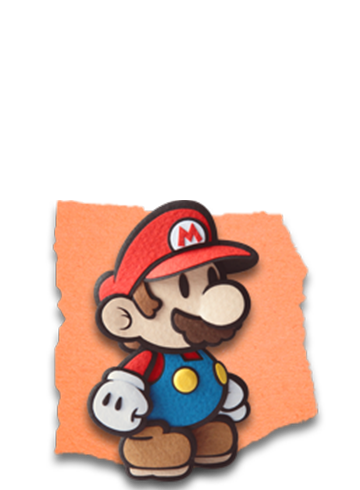
30 notes
·
View notes
Text
Sonic 25th Anniversary Artbook by Cook & Becker
I think I should've wrote this maybe sooner but... the Sonic artbook by Cook & Becker simply sucks compared to stuff like the Japanese Splatoon artbook or the Mega Man Complete Works. And I love Sonic more than both of these franchises. So let me list the things about this book that really, really bothered me.
The size
I hate this size. It’s 32 H x 28 W cm. Who'd want to use this? It's heavy too; 2.2kg/4lb. Most shelves aren't even this tall. It can't fit in! I have it constantly laying there on my table, collecting dust. Why couldn't be the size of a book like the Japanese Splatoon one or the Mega Man Complete Works artbook. Coffeetable size is horrible.
Reference images
That's something a bit odd but I really would've loved to see. There's some reference art for the classic renditions of the characters... but the Adventure-style has no reference images (the reference image it does have is a Sonic X one). And I really hate that because there are some reference sketches floating online but all the Japanese notes are untranslated and it would've really helped me at figuring out how the heck I can draw these renditions.
Too much text, it's not a documentary, idiots.
Cook & Becker, hear me out. No one gives a crap about the history of a video game franchise in an artbook. Unless you got together the artists of these images and interviewed them to get some kind of information about the art, cut the text out. You're wasting ink and the writer's time here. People who bought an art book about the video game franchise they love, don't need to hear about what a particular title is about. Or what a fucking ring is. We already know that if we're such nerds to buy a damn artbook about it.



Take some notes from the Mega Man Complete Works artbook. That one does have some text but it’s actually kinda needed sometimes. It explains the game in a couple of short sentences and then quickly goes onto what the artists have to say about some of the art they made.

The layout
I hate this layout. Sometimes, they made the art often span across 2 pages which might sound cool for one second until you realize that you can't see the flipping middle of the art! Yeah! Great! Who cares about looking at the art without troubles? Making the user have a hardtime seeing the art is way better than looking at it without problems on one page! And sometimes they just decide to overlay one image on top of another so all that time finding the rare art was for nothing because some moron thought that this layout was a great idea.
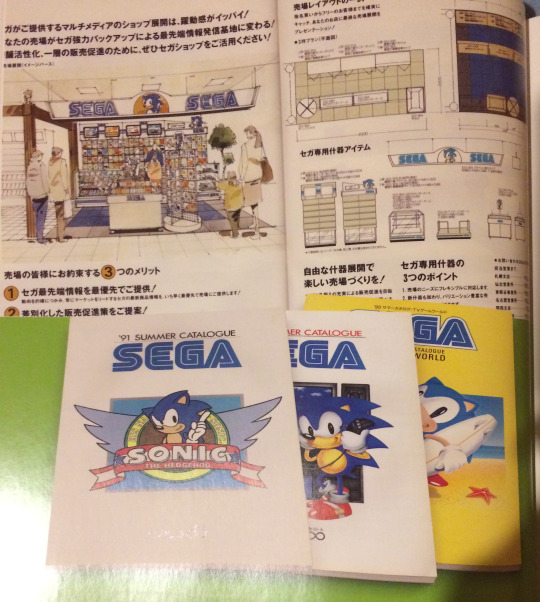

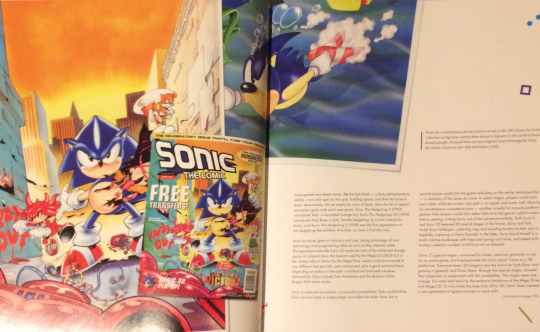
Sometimes they go with a chronological character art layout, then they'll switch to art from games. Have some consistency here! Oh, what am I talking about? This is something Sonic related from 2016, it won't have consistency. Even if it's an artbook!
Wrong facts
Sonic 3D Japanese art dates
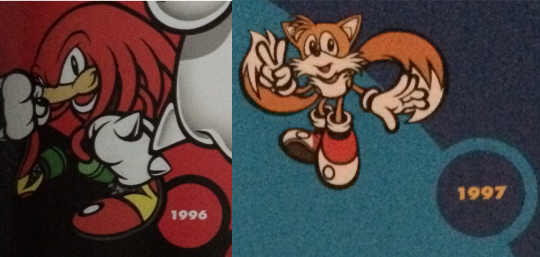
Hey, guys, you goofed up. Knuckles' page lists dates and the Japanese Sonic 3D art says "1996". Yet the Tails one says "1997". And both are wrong. Sonic 3D released 1999 in Japan. That's why they have their Adventure artstyle here. You could've looked this up in 20 seconds by googling "Sonic 3d release dates".
Sonic X being on the same page as Adventure Sonic
They accidently put Sonic X-Sonic on the same page as Adventure Sonic art.

Stuff missing (X-Treme? Saturn?)
The book mentions the cancelled game title "Sonic X-Treme", yet it never shows art from it. I don't get why, it's not like there's no concept art from other cancelled games in there, like Crackers. And why isn't there much Saturn era stuff? I know that Sonic didn't have many games during that but there's a lot of stuff missing. Like the Sonic Jam pre-rendered models or the wallpaper art. Heck, throw in some Sonic the Screensaver concept art too. It's like they gave up at archiving the art one third-way through.
Other missing stuff
Chao concept art
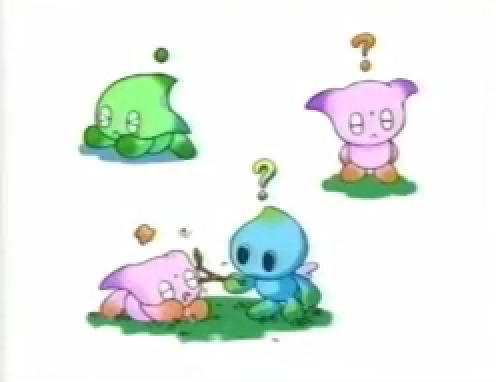
During the unveiling of Sonic Adventure, there was concept art of the Chao shown. Why is the only thing on there 3 very common Chao artworks?
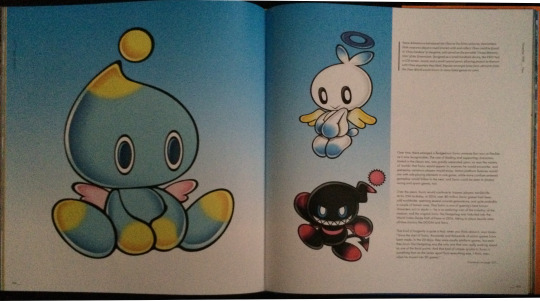
Sonic Adventure art in general Yo, Sonic Retro has a ton of Adventure art archived. Why don't you guys put that in the book? Or that weird looking Sonic art from the front of Sonic.

Sure, it looks kinda bad but it's very rare. Something that you guys said was that you were looking for a lot of rare images to archive in that book. I only see a couple of them here. Most of the time, it's either stuff I've seen 100 times before or something rather recently discovered.
Environmental concept art I would've loved to see more concept art for Sonic's levels. Things that happen in the level, what the level looked like, level design sketches... That should've been in the book.
Rare art I'll just put a ton of low quality images on there that are pretty much either lost, uncommon or rare which you guys could've put in the book. For shame, for shame! https://imgur.com/a/IDc3r
"What the actual shit"-part
This is the part where I can just go "What were they thinking?!". I can't find a reason why they did this and it makes no sense why they did it.
Pages that fold out which are just screenshots of the fucking games

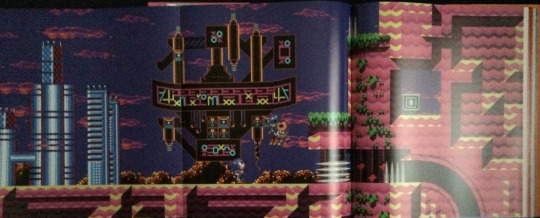

Do I have to point that out why this is such a bad idea to begin with? If I want to look at the game, I'll play the actual game. And why do these pages fold out? None of the other pages do this, heck, the art that spans across pages would've needed that instead of these images.

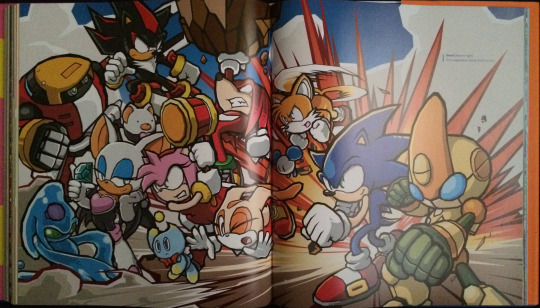
Anyways...
Transparent pages that don't line up with the art on the other page
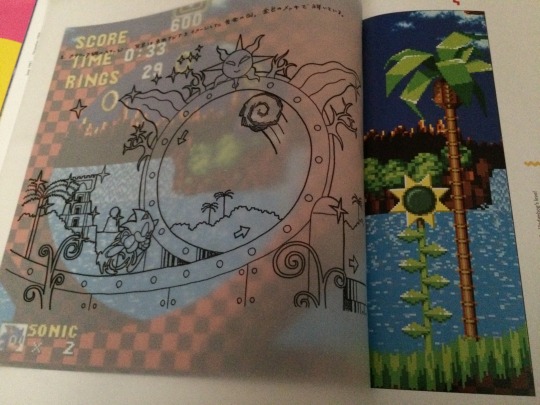

Just look. This is a transparent page... where you can look through it to view another page... And it doesn't line up or has anything identical in the slightest. So... why make it transparent?
Sonic 2's Japanese box art
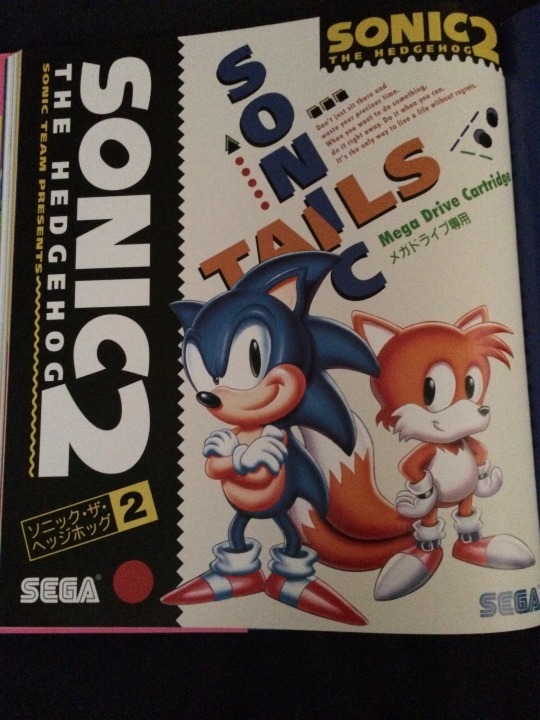
You photoshopped American Sonic and Tails on top of the Japanese Sonic 2 boxart. That's disgusting, you know that?
Pages that show sprites Look. Pixel art is still art. I get that, it takes time to put something complicated in a restricting format. But... you can look up sprite sheets online and you'd get the same expierence as looking at this book. I bought this book to look at rare or even unpublished art of Sonic. Some may have bought it to see high quality images of Sonic's art. I doubt that anyone bought this to look at pixel art because you can look at that online for free. Wasting pages with something that you can look up online for free in 20 seconds is not a good thing in your artbook to have.
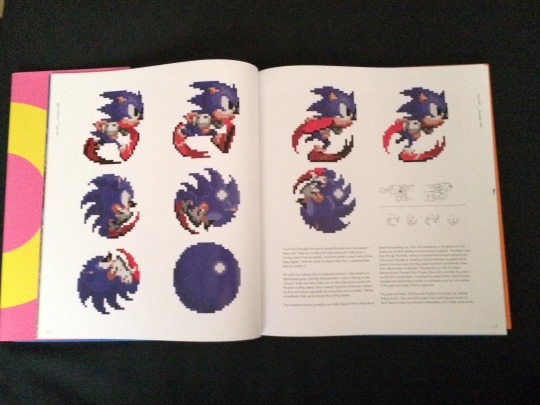


Even Mega Man Complete Works artbook has 0 pixel art. The franchise known for being in the 8-bit pixel form for 8 out of 11 games.
A page about the ring

This page is pure filler. How did they get away with this? Someone at SEGA and at Cook & Becker had to look at this and think "This is great. Ship it.". I now should either have no faith in SEGA in Quality Assurance checking now or won't trust Cook & Becker as a company ever. Maybe both.
With that said, I wouldn’t ever recommend this book to anyone. This artbook is the Sonic Forces of artbooks. I bet if a lot of fans would come together and find and scan all the Sonic art they could find, they’d make a much better artbook than this atrocity. So get the Kirby artbook instead, I guess? Ugh...
30 notes
·
View notes
Note
Yo Noid 1 when
Yo Noid 1, more like...
.
..
...
https://www.youtube.com/watch?v=a3mTsmW9AKs
1 note
·
View note
Note
in your review of rhythm thief id like to point out an error- the mobile port is titled paris caper in the us and premium live in japan (theres only 1 mobile game). service ended in 2015 for both jp and us players :(
That‘s actually why I said “a no longer available, abridged mobile port”. ^^‘And, from what I know, only the title is different… besides being abridged.
...Oh, I see now, both titles are one game. Gonna fix that!
3 notes
·
View notes
Text
Rhythm Thief & the Emperor's Treasure
Rhythm Thief & the Emperor's Treasure is an Adventure-Rhythm game by SEGA and Xeen in 2012. And I hope you guys will enjoy the holidays, by the way.
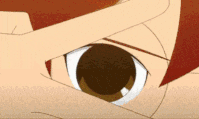
Rhythm Thief is a game about a kid in Paris, named Raphael, who is disguising himself as an art thief called Phantom R. Together with his dog, he's searching for his father, who disappeared 3 years earlier. He and his dog team up with Marie, after finding out her violin bears the same symbol as a coin Raphael's father dropped before disappearing. He learns that her mother is missing, too. Together, they try to unravel the mystery... through rhythm games.
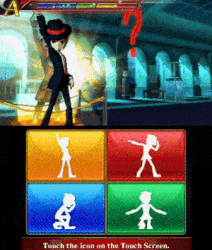
The rhythm games and music are often really well done. In the beginning of the game, you only have to press or use the stylus to do one specific thing and time it well to the rhythm. There are often in-game cutscenes between the portions of a game and those are done really well for an early 3DS game. It reminds me of Jet Set Radio's animations sometimes, actually. There are actually some optional games that are heavily based on Samba De Amigo and Space Channel 5 so... seems fitting.

Later on though, you have to use motion controls at least three times and when you have to do a lot of quick things one after the other, you practically need to look at the helper icon or else, you'll fail because the song doesn't do a well enough job to prepare you to press the buttons or the stuff on-screen just comes at you way too fast. The Rhythm Heaven/Paradise games knew that they have to warn the player before they have to do certain things. If they wouldn’t do that, it turns into Rhythm Thief's later half of the game where you either have to memorize everything or closely look at an optional helping icon and time the action properly. And even then, it might not give you enough time to react.
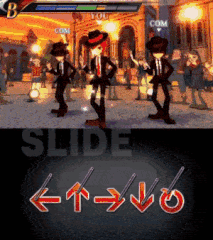
And the less I say about the motion controlled games the better... okay, I'll say it, they suffer from the same exact flaws. The animations are too quick and the music/sounds don't give enough signs on what to do. And add that together with moving the screen to an extent where you can't sometimes tell what to do and you'll have the worst moments of the game.

The moments it shines is when they're using vocal songs or simple controls. I honestly wish vocal songs would've worked like that in Sonic Forces... they both had the same sound director so I don't see why-- whatever. Point is, the vocal songs themselves are great. There's only one song out of the whole soundtrack that irks me, Searching For A Sound. It sounds like a Sonic Shuffle song to me, what happened?
When you're not playing the rhythm games, you're exploring Paris through a Professor Layton-esque view. You know, touching everywhere on the screen to find coins, talking to (sometimes ugly) NPCs, reading through textboxes, going to a specific spot to advance the story & the map and so on.

What's different though is that you can tap on certain objects and it'll save the sound of said object so you can use it somewhere else. But it will never get too cryptic. It's just some quick puzzle solving.
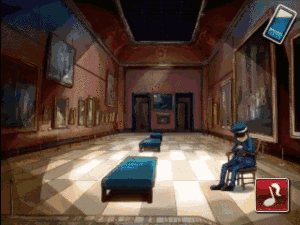
And when you're not doing any of that, you'll get to watch one of the many animated cutscenes. They're really cool looking, I didn't expect that from a 3DS game by a third-party publisher. Even if they suffer from bad translation issues, like typos, bad voice direction or the voice actors reading an earlier draft of the script constantly. It's not the worst localization job I've seen but it's very amateuristic.
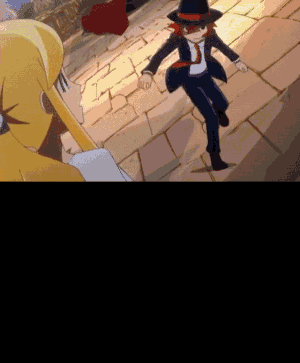
Speaking of the script... I can see what it wants to be but there are some seriously odd decisions in there but giving that away involves spoilers so... go to this post where I'll say some spoiler-heavy stuff of the game to mention my issues with the story.
In 2012, the director, Shun Nakamura, said that he'd want to do a sequel for 3DS or Wii U... I'd definitely would love to see them giving a sequel to this game a shot. They could improve flaws, like making a better written story and maybe throwing away stuff that didn't work, like motion controls or making the games unneccessarily complicated. I think this has potential to be really great. But so far, we only have this "just good"-game and a no longer available abridged mobile port. I'd recommend Rhythm Heaven/Paradise on DS and Wii over Rhythm Thief, that's for sure but if you want something different from a Rhythm Heaven/Paradise game, you might like it. It's certainly better than HarmoKnight.
4 notes
·
View notes
Text
My issues with some of Rhythm Thief’s story
Please don’t read this unless you want to get spoiled (yes, this game is kinda story-heavy) or unless you already played through the game!
So, for a gun, there sure are very silent gunshots. But besides that, for the first “gunshot” scene, Phantom R gets shot. As in, he falls to the ground and has an obviously very hard time getting up. After a cutscene and a game about rescueing Phantom R, he says it’s just a scratch and it’s completely fine. Uhm...? You got shot, right?? Or was it a show? What was your plan with that?!? The second “gunshot” scene is around the end of the game where Elisabeth gets shot and has a death scene. Except, she’s not dead as we find out about 2 rhythm games or so later through dialogboxes. Why make a death scene then? What’s the point of involving guns in this story when they never harm people? I’m not saying they both should die or something but why write it like that and then scrap it? Was the script writer told to redo the script to tone it down but he/she still wanted to keep those scenes in? Hm... Makoto Goya really likes having the balls to harm characters in a way it won’t matter in the long run.
And I still don’t understand how the voice actors and the in-game text doesn’t match sometimes. An obvious example is when Napoleon calls someone an imbecile but the voice actor says something like “children”. Did the voice actors get an early translation or something? And why is Marie’s voice direction (the English one) very... unemotional? The English voice acting is overall acceptable, as I’ve said but I think they could’ve recorded more takes for the cutscenes because I think they could’ve done a bit better.
And I don’t get the ending at all. Why are they parting ways from each other? I read through the dialog multiple times but either I missed it from a waaaaay earlier cutscene or there was no reason.
I think that’s all the problems I had with it.
1 note
·
View note